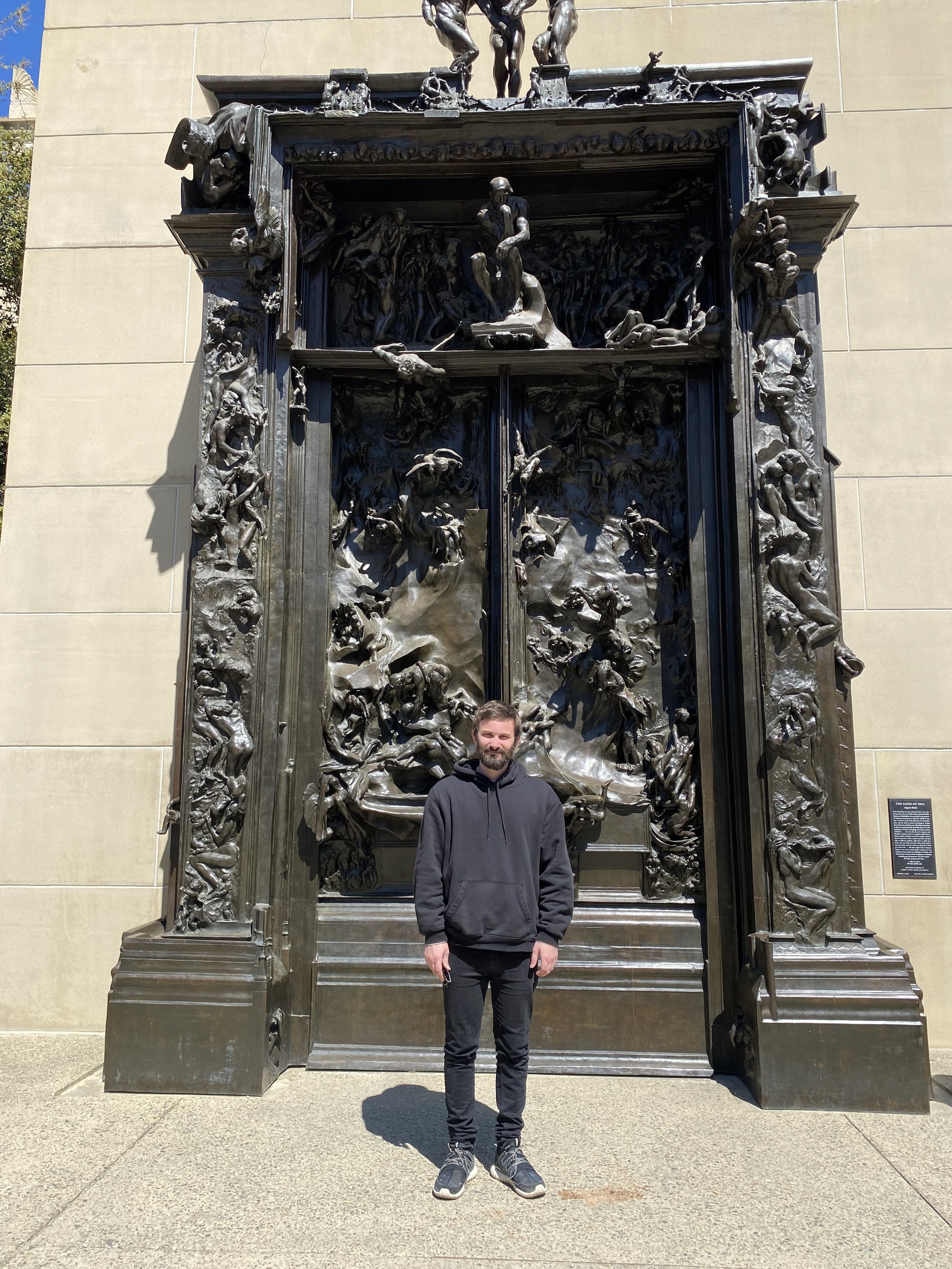Rodin’s Gates
Rodin’s Gates
16 in x 20 in, oil on canvas, 2021.
This painting pays homage to The Gates of Hell by Auguste Rodin (France. 1840-1917). The Gates of Hell is a bronze sculpture that is influenced by the Inferno, themes which are prevalent in Rodin’s work. I have always been interested in reading the Inferno and saw fit to finally realize this goal alongside the creation of this piece. I immersed myself in the worlds that both Dante and Rodin created. This culminated in a visit to The Gates of Hell at Stanford University, which imprinted a visceral connection to a historic art piece that I have never felt prior.
My recreation focuses on the left panel of Rodin’s great gate and omits the right panel and tympanum. This is in part due to my intrigue with the uppermost figure, The Falling Man. I felt inspired by this figure and the overwhelming sense of desperation that it conveys as the figure attempts to escape the fall. In my recreation, this figure is not only falling but being pried from the tympanum by a malevolent creature. I then used this as a motif and added several more “falling men” throughout the scene, to emphasize motion, give a sense of scale to the work, and pull viewers into Rodin’s gates just as I was when I explored the original. The prominent floating orbs from my other work are continued in this piece, as an extension of my artistic exploration of underworld scenes and stories.
The sides of this painting are embellished with gold impasto oil paint, which is a nod at another one of Rodin’s main inspirations, Gates of Paradise by Italian Renaissance artist Lorenzo Ghiberti (1378-1455 AD). This great golden door located at the Florence Baptistry (Battistero di San Giovanni) includes 10 gilded bronze panels, each depicting a scene from the Old Testament. Rodin’s gates serve as his response to this master’s work. Ghiberti’s doors radiate an awe inspiring human interpretation of heaven, while Rodin’s a cold, uneasy and sometimes sinister representation of hell and hopelessness. In addition, the decision to use gold impasto was inspired by another one of Rodin’s fascinations as an Impressionist, the play of light on the surface of his work. His figures cast dark shadows and bright highlights, and integrating a somewhat three-dimensional texture into my work serves this purpose.
Lastly, I would like to provide some information about the bottommost portion of this painting. Here you see a large hulking figure and a smaller figure draped on its shoulder to the right. The larger figure is that of Ugolino an Italian nobleman whom Dante placed deep within the second ring of the lowest circle in the Inferno, for his traitorous deeds. The smaller figure is one of his sons. Shortly before Dante’s time, Ugolino played a major role in the dispute between the Ghibellines and the Guelphs, two warring factions of Florence. This ultimately led Ugolino to be imprisoned along with his sons in Pisa, within a tower named the Muda. After some months, the keys to this tower were thrown in the Arno river, and Ugolino and his sons were left to die of starvation.
As a historical figure, the story of Count Ugolino has been retold and portrayed in art and literature many times over, including the renowned sculpture of the figure by Jean-Baptiste Carpeaux, completed when Rodin was a young man. In some renditions of the story, including Dante’s, Ugolino’s sons bid that their father satiate his hunger on their own bodies. Dante, leaves the following events up to the reader, while Rodin takes the scene further and places Ugolino crouched over one son preparing for the horrendous act. If Rodin’s version is to be regarded as true, I added more grotesque features to the character, including horns and a more bulky and distorted figure, to reflect his monstrous actions suitable for the ninth circle.
For those who want to learn more:
Gates of Hell: https://en.wikipedia.org/wiki/The_Gates_of_Hell
Auguste Rodin: https://en.wikipedia.org/wiki/Auguste_Rodin
Dante Alighieri: https://en.wikipedia.org/wiki/Dante_Alighieri
Divine Comedy: https://en.wikipedia.org/wiki/Divine_Comedy
Ugolino della Gherardesca: https://en.wikipedia.org/wiki/Ugolino_della_Gherardesca
Gates of Paradise: https://en.wikipedia.org/wiki/Lorenzo_Ghiberti







